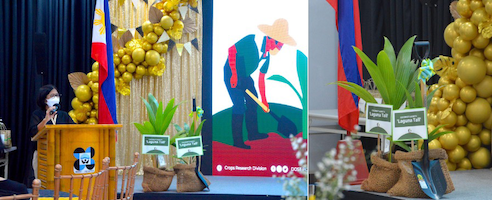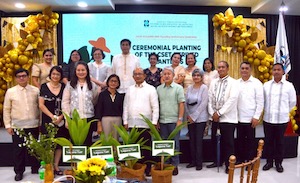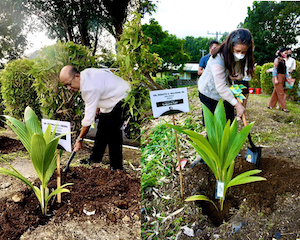
The Philippine Council for Agriculture, Aquatic, and Natural Resources Research and Development of the Department of Science and Technology (DOST-PCAARRD) highlighted Coconut Somatic Embryogenesis Technology or CSet-derived coconut planting materials, another Tatak GALÍNG, gáling PCAARRD coconut innovation, during its 50th Founding Anniversary held recently.
Dr. Cristeta A. Cueto, Department Manager of the Philippine Coconut Authority - Albay Research Center (PCA-ARC), presented the planting materials in the “Ceremonial Planting of the CSET-Derived Plantlets\'\' event organized by the Crops Research Division (CRD). The plantlets were among the primary outputs of the five-year DOST-PCAARRD-funded program titled “Reinvigorating the Philippine Coconut Industry through the Coconut Somatic Embryogenesis Technology,” under the overall leadership of Dr. Cueto.
CSet is a mass propagation strategy for coconut using plumular tissues, or the young shoot from the embryo, of high-yielding tall, dwarf, and hybrid varieties. Currently, Baybay Tall (BAYT), Laguna Tall (LAGT), and Malayan Red Dwarf x Tagnanan Tall (MRDxTAGT) respond best to CSet.

“CSet is a breakthrough technology and viable tool to boost the local coconut industry,” DOST-PCAARRD Executive Director Dr. Reynaldo V. Ebora stressed in his opening message.
CSet has the capacity to produce hundreds of plantlets from a single plumule compared with the traditional method where a seed nut can only generate one plantlet.
While emphasizing its potential, Dr. Ebora assured the extended assistance of the Council to the CSet program through its Industry Strategic S&T Program (ISP) for the Coconut and Coconut Hybridization Program (CHP) of the Coconut Farmers and Industry Development Plan (CFIDP).
Likewise, DOST Undersecretary for Scientific and Technical Services Maridon O. Sahagun, on behalf of DOST Secretary Hon. Renato U. Solidum, Jr., reaffirmed the importance of CSet in potentially increasing the production of the local coconut industry. She also reassured the continuous support of the Department in such efforts that will benefit Filipino coconut farmers in the future.

Meanwhile, University of the Philippines Los Baños Vice Chancellor for Community Affairs Roberto P. Cereno, on behalf of Chancellor Jose V. Camacho, Jr., expressed the support of UPLB for the program. UPLB is one of the implementing partners of many DOST-PCAARRD-funded programs and projects, including the CSet program.
Guests coming from partner implementing agencies such as the PCA - Zamboanga Research Center (PCA-ZRC), UPLB, and Bicol University College of Agriculture and Forestry (BUCAF) graced the event. The DOST-PCAARRD Directorate and staff also attended the activity.
After the brief program, everyone gathered for the ceremonial tree planting in the hopes that the CSet planting materials would grow and serve as a constant reminder to work together for excellence in coconut research and innovation.
